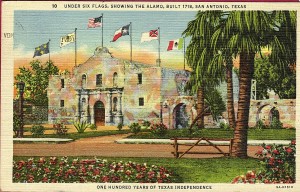Alamo battle featured many flags
One of the earliest accounts of the fall of the Alamo, the famous battle in the drive for Texas independence from Mexico, appeared in The Louisiana Advertiser. It ran about three weeks after the March 6, 1836, assault that captured the former mission and killed – among scores of others – Davy Crockett and Jim Bowie, two legendary frontiersmen.

While historians continue to debate precisely what happened at the Alamo, one thing is for sure: There were plenty of flags at the siege. For example, the attacking Mexican troops waved a black flag as a symbol that they would take no prisoners. Also, the newspaper noted that “the flag of Santa Anna’s army…was a blood red one, in place of the old constitutional tri-colored flag.”
General Santa Anna led the Mexican forces. The tri-colored Mexican flag consisted of vertical bars colored green, white and red.
The news report also tells how two of the handful of survivors of the battle – “Mrs. Dickinson and Col. Travis’ servant” – were allowed to go to General Sam Houston’s camp “accompanied by a Mexican with a flag.” That banner would have been a white flag of truce to ensure the safe delivery of the woman – Susanna Dickinson, wife of one of the deceased Alamo defenders – and a servant named Joe.
During the battle, Col. William Travis, who commanded the troops, penned a letter that explained why he was doggedly holding the line against the Mexican army. Referring to a concurrent constitutional convention, he declared: “Let the Convention go on and make a declaration of independence, and we will then understand and the world will understand what we are fighting for….Under the flag of independence, we are ready to peril our lives a hundred times a day.”
Texas is now known for existing under six flags, which would give rise to the name of a string of amusement parks. The half-dozen are the flags of Spain, France, Mexico, Texas itself, the Confederacy and the United States.
